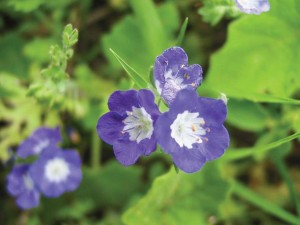
South Texas Sand Sheet’s unique treasures uncovered

Immense biodiversity exists on a treasured chunk of Texas.
A region spanning over 2 million acres across nine counties holds a variety of plant life comparable to the Everglades.
The South Texas Sand Sheet, Coastal Sand Plain, Llano Mesteño, or however you choose to refer to it, stretches across all or portions of Kleberg, Jim Wells, Duval, Jim Hogg, Brooks, Kenedy, Willacy, Hidalgo and Starr counties.
The area is characterized by big ranches and sandy soil, the remnants of an ancient sea and the reason for a unique habitat filled with diverse vegetation.
Landowners in the region who once might have been frustrated wading through botanist jargon while trying to identify the myriad of flora on their land now have a layman’s field guide available to enlighten themselves.
Dexter Peacock, a Hebbronville rancher, and Forrest S. Smith, a native plant restoration expert, teamed up to create “A Photographic Guide to the Vegetation of the South Texas Sand Sheet” (Texas A&M University Press).
The field guide takes an innovative approach to indexing the Sand Sheet’s plant life in a way that is simple for those who have not taken a college botany course.
Peacock’s search for knowledge about his land led him to a bunch of books written by botanists for botanists. He found himself scouring through hundreds of pages to find what he was looking for in books organized by genus and species.
“And for crying out loud, if we knew what the genus and species of the plant that we had in our hands were, we wouldn’t need the book anyhow,” Peacock quipped.
“A picture’s not much good if you don’t know what you took a picture of.”
Instead, Peacock and Smith organized their field guide by appearance, putting flowers that look similar next to each other in the guide so they’re easy to find. Peacock, an avid photographer, mentioned how scholarly publications often use small, hard-to-identify photographs, so he and Smith remedied that by using 365 vibrant photos from Peacock’s 2,000-acre ranch and others in the region.
The field guide also displays multiple photos of some plants during different times of the year for additional guidance.
“No matter what books are out there, if they’re not landowner friendly, they still aren’t able to get the end need of identifying the plant,” said Smith, the Dan L. Duncan endowed director of the Texas Native Seeds Program at the Caesar Kleberg Wildlife Research Institute.
The field guide distinguishes native and invasive species and is divided into sections that identify weeds and forbs (both conspicuously and inconspicuously flowered forbs), grasses, shrubs with and without thorns, trees, cacti, yuccas and vines. The book uses scientific, common and Spanish names when identifying each plant.
Under each plant is a brief description packed with loads of information pertinent to landowners, hunters and students. The descriptions are written in simple, straightforward language, a product of the back-and-forth process between Peacock and Smith.
Peacock, 78, and Smith, 39, were brought together by their involvement in the Kleberg institute, a top-tier nonprofit research organization in Kingsville. Smith began work with the institute in 2001 as a student technician and became a full-time employee two years later.
The two brought very different perspectives in making the field guide, creating an easy-to-use book that provides a pathway to the scholarly literature.
“This was the only endeavor I ever got involved with where ignorance turned out to be an asset,” said Peacock, who practiced corporate law in Houston for nearly 50 years.
Peacock and Smith blended science and simplicity in a way that allows the field guide to be utilized by all.
One of the guide’s greatest resources is the knowledge it provides land managers.
The Sand Sheet is one of the least fragmented areas in all of Texas and holds priceless habitat. It is home to the legendary King, Kenedy and Armstrong ranches, and land conservation has been practiced here for decades. Cattle can easily create sand dunes, and ranchers in the area are sensitive to overgrazing.
“One of our goals was to elevate the knowledge and status of that area so that generations to come are focused on conserving it, too,” Smith said.
Smith said a person can peer into the history of a landscape by examining the plants on it. The field guide provides plenty of clues that can help a person assess a piece of property.
“When you go through a gate, whether you’re going to hunt, or whether you’re thinking about buying the property or whether you’re managing it, you’ll have some ideas, some indicators of good things or things that can be worked on,” Smith said.
Plant descriptions are filled with nuggets that shed light on each plant’s use for game animals such as deer and quail. For quail, the South Texas Sand Sheet is a mecca.
“It’s no accident that the best bobwhite quail hunting left in the world is the Sand Sheet,” Smith said.
Along with advantageous vegetation, the area gets moisture from the nearby coast that nurtures plant life and gives quail refuge even in drought years.
“A lot of the plants that quail really thrive on and eat and use for different reasons do well in the sandier soil,” said Robert Perez, upland game bird program leader for the Texas Parks and Wildlife Department.
“God just made those areas really good for quail.”
The landscape of the Sand Sheet is a prized slice of Texas, an area unlike anywhere else in the world.
The book documents more than 200 plants, and over 50 of those species are endemic to Texas. The field guide contains 15 species that can be found only in the Sand Sheet.
The ecological medley makes it easy to see why Peacock, Smith and many others have fallen in love with the place.
“Oh God, yeah,” Peacock said when asked if he underestimated the Sand Sheet’s diversity.
“The more you know about that area, the more you love it.”